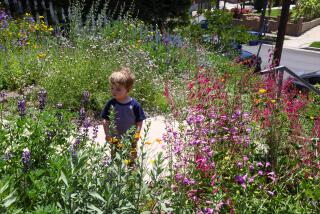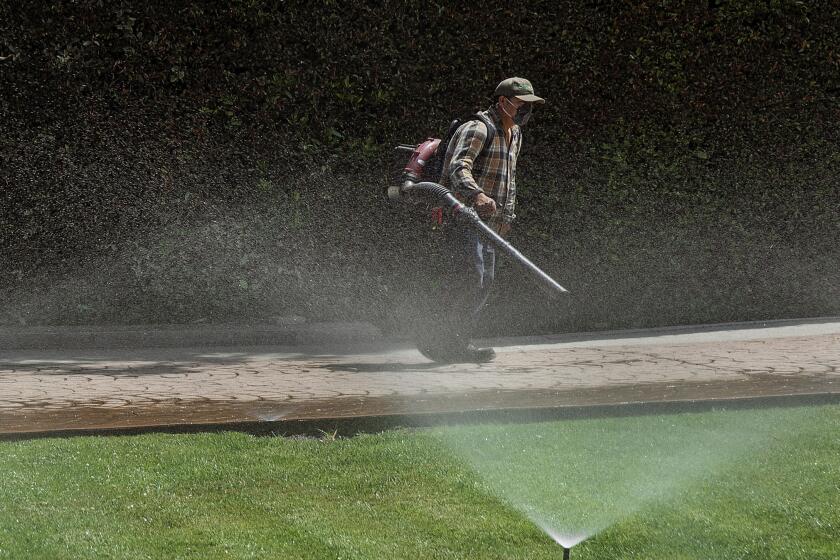A Dirty Gardening Secret : Ex-Journalist’s Probe Unearths Key to Green Lawn in a Drought
- Share via
The old-time newspaper editor sized up the grassy lawn behind his Glendora home. Then he sized up the visitor with the notebook who was standing on it.
“This is probably the most important story you’ll ever write,” Joe Willis told his guest.
Fifty-eight years after starting out in journalism, Willis was delivering another scoop: At a time of drought, there’s a simple way for Southern Californians to keep their lawns green and their water rationing records clean.
Willis, 80, said it didn’t take any special digging on his part to figure out how. Just probing.
It’s easy to convert the long metal handle that many homeowners use to turn on their lawn sprinklers into a soil probe that can tell them when to keep the sprinklers turned off, he said.
Widespread use of such simple probes could save millions of gallons of water, Willis says. And when rationing takes on added urgency during the coming summer months, they could save thousands of lawns.
If that’s news to Los Angeles-area homeowners who have given up on their yards for this year, it’s old hat to professional gardeners and landscapers. And to ranchers and farmers from Glendora, Novinger, Mo., and Oakland City, Ind.
Those are farming towns where Willis edited and published country newspapers during a career that started in 1933.
There were more orange trees than people in the northeast San Gabriel Valley in 1945, when Willis became editor and publisher of the Glendora Press, a tiny weekly paper. Back then, residents took water seriously because it came from local wells.
The citrus business was often the big story of the week for Willis’ paper. So when he planted a vegetable garden at his then-new Leadora Avenue home, two local agricultural experts were quick to offer the editor some watering tips.
Packing plant manager Merrill West showed him how to probe the soil for moisture by scraping the ground with his toe. Damp soil looked dark when unearthed; dry soil that needed irrigation was a lighter color.
Orchard consultant Marvin Rounds, then a retired horticulture professor from UC Riverside, went West one better. Rounds suggested that Willis use a metal stick to check on moisture further down, beneath his plants’ roots.
“He went to a machine shop and had a soil probe made out of a steel rod with a T handle on it,” Willis said. When it was finished, Rounds poked the rod into the ground and showed Willis that he was wasting precious well water by over-irrigating.
These days, there is no need to have a special probe made. A suitable substitute--the 3-foot-long lawn sprinkler handle--is available for a few dollars at most hardware stores.
Homeowners should cut off the handle’s prongs and sharpen the bottom end, Willis said. Then they should mark the shaft with a notch to show the depth of their lawn’s roots. Most grasses’ roots extend 4 to 6 inches, he said.
When the sharpened end is poked into the ground, it will easily slide through moist earth. But it will stop abruptly when it hits dry soil, which is “as hard as concrete,” according to Willis. If the notch mark is still showing when the probe stops at dry soil, it’s time to water.
The underground moisture level changes daily, shrinking from the bottom, he said. Homeowners who use the probe can turn off automatic sprinkler timers and avoid wasting water.
Long retired from the Glendora Press, Willis remains a familiar character around town, where he now serves as an occasional “contributing editor” to another paper, the Glendora Signal.
In his spare time, he is writing a pamphlet about the use of the soil probe. He plans to give the brochure to Glendora merchant Cecil Watts, who has acquired a supply of sprinkler handles to be converted into probes and sold.
Willis is working with Watts as a volunteer with Glendora’s Service Corps of Retired Executives, a group that assists new businesses and young business people.
But that’s another story.







